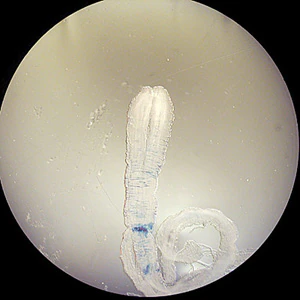 Spirometra spp. are tapeworms responsible for sparganosis, a parasitic infection that primarily affects humans when they become accidental hosts. Unlike most tapeworms, which remain confined to the intestines, the larvae of Spirometra can migrate through the body tissues, leading to serious health problems. The infection typically occurs through the ingestion of undercooked or raw meat from infected animals (such as amphibians, reptiles, or mammals) or by drinking contaminated water containing infected copepods (tiny freshwater crustaceans).
Spirometra spp. are tapeworms responsible for sparganosis, a parasitic infection that primarily affects humans when they become accidental hosts. Unlike most tapeworms, which remain confined to the intestines, the larvae of Spirometra can migrate through the body tissues, leading to serious health problems. The infection typically occurs through the ingestion of undercooked or raw meat from infected animals (such as amphibians, reptiles, or mammals) or by drinking contaminated water containing infected copepods (tiny freshwater crustaceans).
In humans, sparganosis often manifests as a migrating mass or lump under the skin (subcutaneous sparganosis). The larvae can also invade deeper tissues and organs, including the eyes (ocular sparganosis), brain, lungs, or muscles, depending on the site of migration. Symptoms vary based on the location of the larvae and can include pain, swelling, and inflammation. In severe cases, ocular sparganosis may lead to vision loss, and cerebral sparganosis can cause neurological damage such as seizures or paralysis.
Diagnosis of sparganosis is usually made by identifying the larvae in tissue biopsies. Imaging techniques like MRI or CT scans may also help detect migrating larvae in deeper tissues. Treatment generally involves the surgical removal of the larvae from the affected tissues. In some cases, antiparasitic medications like praziquantel may be used, but they are typically less effective for sparganosis than for other tapeworm infections due to the larvae’s ability to migrate and encapsulate.
Preventing sparganosis involves avoiding consumption of undercooked or raw meat from potentially infected animals, as well as ensuring water is properly filtered or boiled to kill any contaminated copepods.



